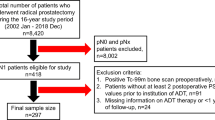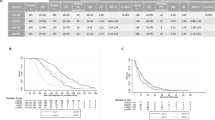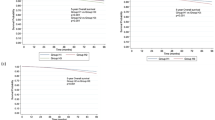Abstract
Background
Patients treated with RT and long-term androgen deprivation therapy (ltADT) for high-risk localized prostate cancer (HRLPC) with 1 high-risk factor (any of Gleason ≥8, PSA > 20 ng/mL, ≥cT3; “high-risk”) have better outcomes than those with 2–3 factors and/or cN1 disease (“very high risk”). We evaluated whether this risk stratification could determine benefit from ltADT versus short-term (stADT).
Methods
The Intermediate Clinical Endpoints in Cancer of the Prostate (ICECaP) repository of randomized trials was queried to identify eligible patients and trials. The key outcomes of interest were metastasis-free survival (MFS), overall survival (OS), time to metastasis (TTM) and prostate cancer-specific mortality (PCSM). Stratified Cox and Gray’s regression were used to obtain the overall treatment effect for outcomes and risk groups, and the Wald interaction test to estimate whether treatment benefit differed by risk group or trial. Heterogeneity of studies was assessed by Cochran’s Q and I2.
Results
2780 patients from 3 trials were included. Patients with very-high risk disease had greater benefit with ltADT compared to high-risk disease (MFS HR 0.77 [0.68–0.88] vs. 0.89 [0.76–1.03]; TTM 0.61 [0.51–0.74] vs. 0.77 [0.59–0.99]; PCSM 0.71 [0.56–0.90] vs. 0.82 [0.59–1.14]; OS 0.87 [0.76–1.00] vs. 0.93 [0.79–1.08]), but there was no statistically significant difference in treatment effect by risk group (p-interaction >0.1). Heterogeneity for treatment effect across trials was low in the very high-risk group and moderate in the high-risk group.
Conclusions
Clinical risk stratification merits further evaluation in clinical trials to identify which patients with HRLPC may benefit from ltADT versus stADT.
This is a preview of subscription content, access via your institution
Access options
Subscribe to this journal
Receive 4 print issues and online access
$259.00 per year
only $64.75 per issue
Buy this article
- Purchase on SpringerLink
- Instant access to full article PDF
Prices may be subject to local taxes which are calculated during checkout

Similar content being viewed by others
References
Kishan AU, Sun Y, Hartman H, Pisansky TM, Bolla M, Neven A, et al. Androgen deprivation therapy use and duration with definitive radiotherapy for localised prostate cancer: an individual patient data meta-analysis. Lancet Oncol. 2022;23:304–16.
Nguyen PL, Huang HR, Spratt DE, Davicioni E, Sandler HM, Shipley WU, et al. Analysis of a Biopsy-Based Genomic Classifier in High-Risk Prostate Cancer: Meta-Analysis of the NRG Oncology/Radiation Therapy Oncology Group 9202, 9413, and 9902 Phase 3 Randomized Trials. Int J Radiat Oncol Biol Phys. 2023;116:521–9.
Armstrong AJ, Liu VYT, Selvaraju RR, Chen E, Simko J, DeVries S, et al. Development and validation of an AI-derived digital pathology-based biomarker to predict benefit of long-term androgen deprivation therapy with radiotherapy in men with localized high-risk prostate cancer across multiple phase III NRG/RTOG trials. J Clin Oncol. 2023;41. https://doi.org/10.1200/JCO.2023.41.16_suppl.5001.
Spratt DE, Tang S, Sun Y, Huang HC, Chen E, Mohamad O, et al. Artificial Intelligence Predictive Model for Hormone Therapy Use in Prostate Cancer. NEJM Evid. 2023;2:EVIDoa2300023.
Ravi P, Xie W, Buyse M, Halabi S, Kantoff PW, Sartor O, et al. Refining Risk Stratification of High-risk and Locoregional Prostate Cancer: A Pooled Analysis of Randomized Trials. Eur Urol. 2024. https://pubmed.ncbi.nlm.nih.gov/38777647/.
Bolla M, de Reijke TM, Van Tienhoven G, Van den Bergh AC, Oddens J, Poortmans PM, et al. Duration of androgen suppression in the treatment of prostate cancer. N. Engl J Med. 2009;360:2516–27.
Lawton CAF, Lin X, Hanks GE, Lepor H, Grignon DJ, Brereton HD, et al. Duration of Androgen Deprivation in Locally Advanced Prostate Cancer: Long-Term Update of NRG Oncology RTOG 9202. Int J Radiat Oncol Biol Phys. 2017;98:296–303.
Denham JW, Joseph D, Lamb DS, Spry NA, Duchesne G, Matthews J, et al. Short-term androgen suppression and radiotherapy versus intermediate-term androgen suppression and radiotherapy, with or without zoledronic acid, in men with locally advanced prostate cancer (TROG 03.04 RADAR): 10-year results from a randomised, phase 3, factorial trial. Lancet Oncol. 2019;20:267–81.
Schaeffer EM, Srinivas S, Adra N, An Y, Bitting R, Chapin B, et al. NCCN Guidelines(R) Insights: Prostate Cancer, Version 3.2024. J Natl Compr Canc Netw. 2024;22:140–50.
Zapatero A, Guerrero A, Maldonado X, Alvarez A, San-Segundo CG, Rodriguez MAC, et al. High-dose radiotherapy and risk-adapted androgen deprivation in localised prostate cancer (DART 01/05): 10-year results of a phase 3 randomised, controlled trial. Lancet Oncol. 2022;23:671–81.
Funding
Funded by the Prostate Cancer Foundation Challenge Award, and grants from Astellas Pharma, Pfizer, Janssen Pharmaceuticals, Millennium Pharmaceuticals, Sotio, Bayer, Dendreon and Sanofi.
Author information
Authors and Affiliations
Contributions
Conceptualization—PR, WX, CJS; Statistical analysis—WX, Provision of study materials—SG, BT, DES, PLN; Writing (original draft)—PR, WX; Writing (review)—all authors; Funding acquisition—CJS.
Corresponding author
Ethics declarations
Competing interests
PR—Research funding to institution from Bayer, Lilly, Telix, Blue Earth Diagnostics, Lantheus, Novartis, Advisory board - Bayer; WX—Consulting Role: Convergent Therapeutics, PCCTC; SG—Personal honoraria for participation in advisory boards from Amgen, MSD; other honoraria from Radio-televisione Svizzera Italiana (RSI), German-speaking European School of Oncology (DESO); invited speaker for ESMO, Swiss group for Clinical Cancer Research (SAKK), Swiss Academy of Multidisciplinary oncology (SAMO), Orikata academy research group, Speaker’s bureau for Janssen Cilag; travel grant from ProteoMEdiX and AstraZeneca; Institutional honoraria for participation in advisory boards or in Independent Data Monitoring Committees and Steering Committees from AAA International, Amgen, AstraZeneca, Astellas Pharma, Bayer, Bristol-Myers Squibb, DAIICHI Sankyo, Janssen, Modra Pharmaceuticals, MSD, Myriad Genetic, Novartis, Orion, Pfizer, Roche, Telixpharma, Tolermo Pharmaceutcials; invited speaker for Swiss group for Clinical Cancer Research (SAKK), Cold Spring Harbor Laboratory, ASCO GU; other honoraria from PeerVoice, Silvio Grasso Consulting, WebMD-Medscape; Patent royalties and other intellectual property for a research method for biomarker WO2009138392; DES—Personal fees: Astellas, AstraZeneca, Bayer, Boston Scientific, GSK, Janssen, Novartis, Pfizer; PLN—research funding paid to institution: Janssen, Astellas, Bayer; Consulting: Boston Scientific, Janssen, Bayer, Novartis, Nanocan; Stock or Other Ownership: Nanocan, Stratagen Bio, Reversal Therapeutics; CJS—research funding paid to institution by Janssen, Astellas, Sanofi, Bayer; Patents, Consulting, or Advisory Role: Sanofi, Janssen, Astellas, Bayer, Genentech/Roche, Pfizer, Lilly; Hengrui; CellCentric, PointBiopharma; Royalties and other Intellectual Property: Parthenolide (Indiana University); dimethylamino parthenolide (Leuchemix); Exelixis: Abiraterone plus cabozantinib combination; FRAS1 SNP and tristetraprolin as biomarkers of lethal prostate cancer; Stock or Other Ownership: Leuchemix. All other authors declare to relevant conflicts.
Additional information
Publisher’s note Springer Nature remains neutral with regard to jurisdictional claims in published maps and institutional affiliations.
Supplementary information
Rights and permissions
Springer Nature or its licensor (e.g. a society or other partner) holds exclusive rights to this article under a publishing agreement with the author(s) or other rightsholder(s); author self-archiving of the accepted manuscript version of this article is solely governed by the terms of such publishing agreement and applicable law.
About this article
Cite this article
Ravi, P., Xie, W., Gillessen, S. et al. Evaluation of clinical risk stratification to determine benefit from long-term versus short-term androgen deprivation in high-risk localized prostate cancer. Prostate Cancer Prostatic Dis (2025). https://doi.org/10.1038/s41391-025-00937-0
Received:
Revised:
Accepted:
Published:
DOI: https://doi.org/10.1038/s41391-025-00937-0



